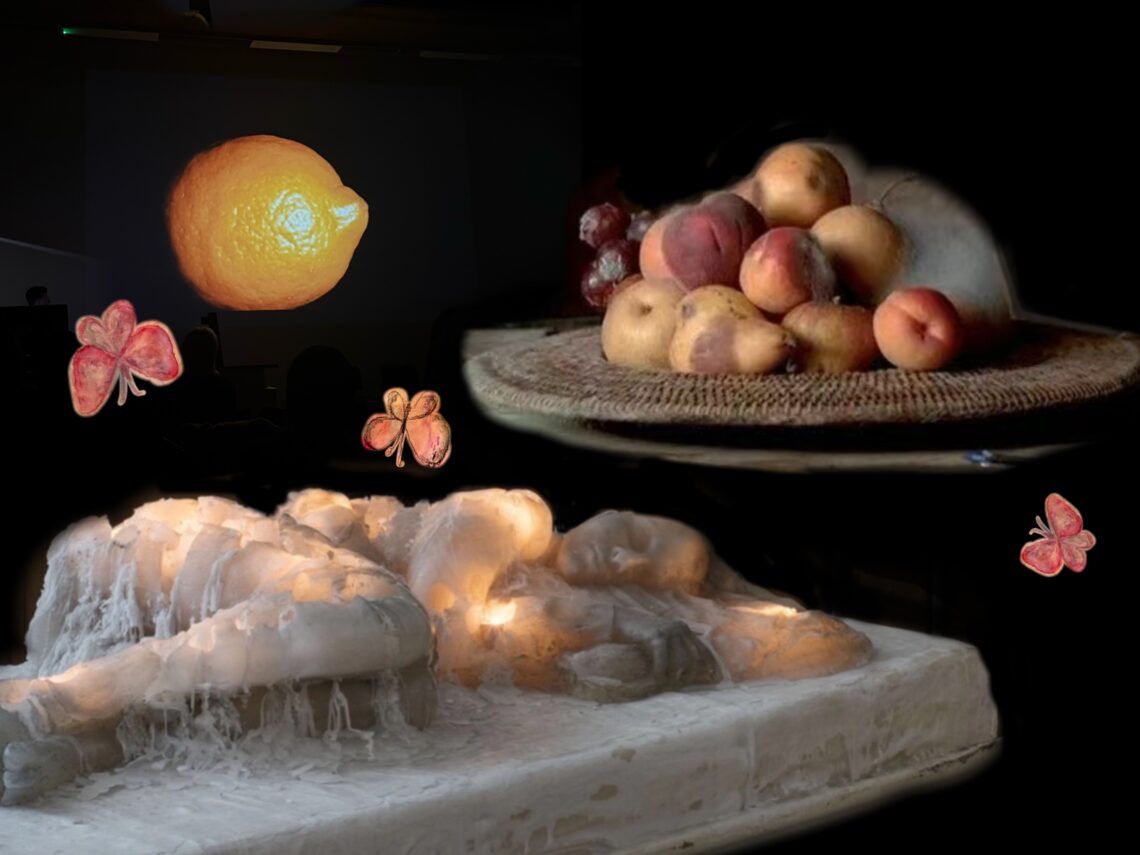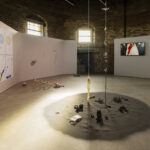Reflections on the Lecture:
This week’s lecture by Marcus delves into the relationship between curation and Time-Based Media.
Marcus refers to today’s ‘Post-Medium Condition’, where the boundaries of media are blurring and moving images and sound have permeated all corners of the exhibition space. However, he did not just discuss the contemporary impact of these works, but emphasised their long history outside of the art world and how independent artists’ organisations can support these forms of creativity.
During his talk, he showed a video of lemons changing in different lights, and in fact, I firstly associated it with the texture of human skin, which looks a lot like the process of human skin aging, and secondly, I thought of the changing phases of the moon. How time, environment and medium work together to shape our perceptions. The light, colour and texture of the surface of a lemon changes, reflecting fluidity, instability, adaptability.
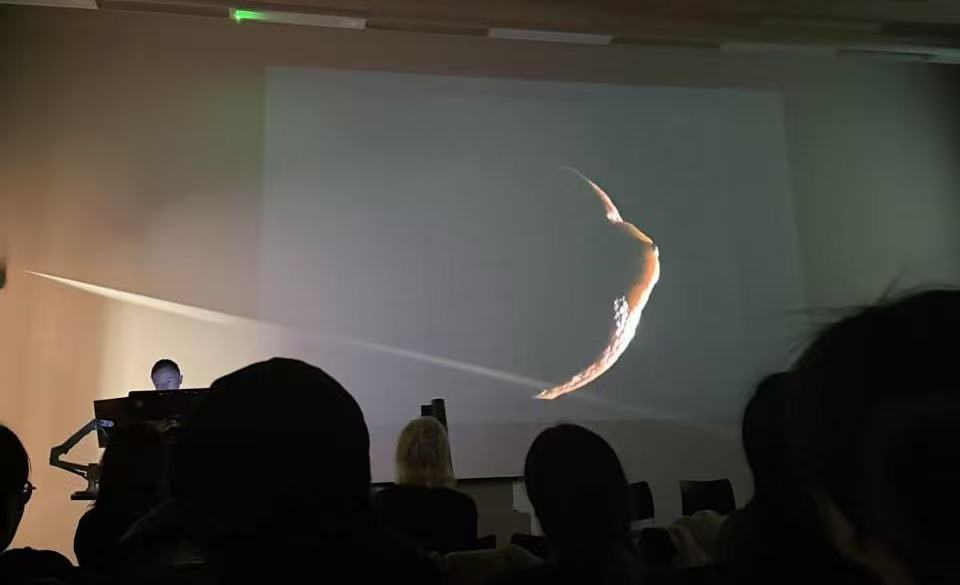
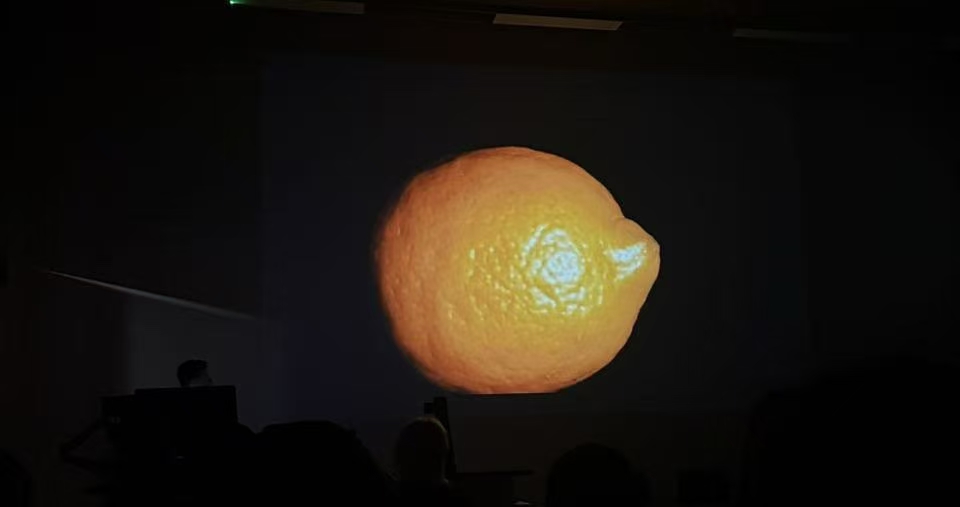
JL read her words aloud, poetically, and I may not have her romantic acumen to capture it.
I wrote:
“In this clip I see light and shadow shining on the lemon, the direction of the light constantly changing, like the earth rising in the east and setting in the west. In this clip, the light and shadow are not fixed, but constantly changing, presenting a dynamic sense of movement. The lemon itself is static, but the light and shadow move across its surface, creating a ‘visibility of time. This is in line with Bellour’s reference to the ‘fluidity of the image’, which cannot be captured statically because it is dependent on the movement of light, which is itself a symbol of time. The image is not frozen, but ‘alive’, and it creates an unforgettable experience of time through changes in light and shadow. Light and shadow here is not just a physical phenomenon, but a symbol: it can be understood as a metaphor for time, the cycle of the universe, and the flow of life.”
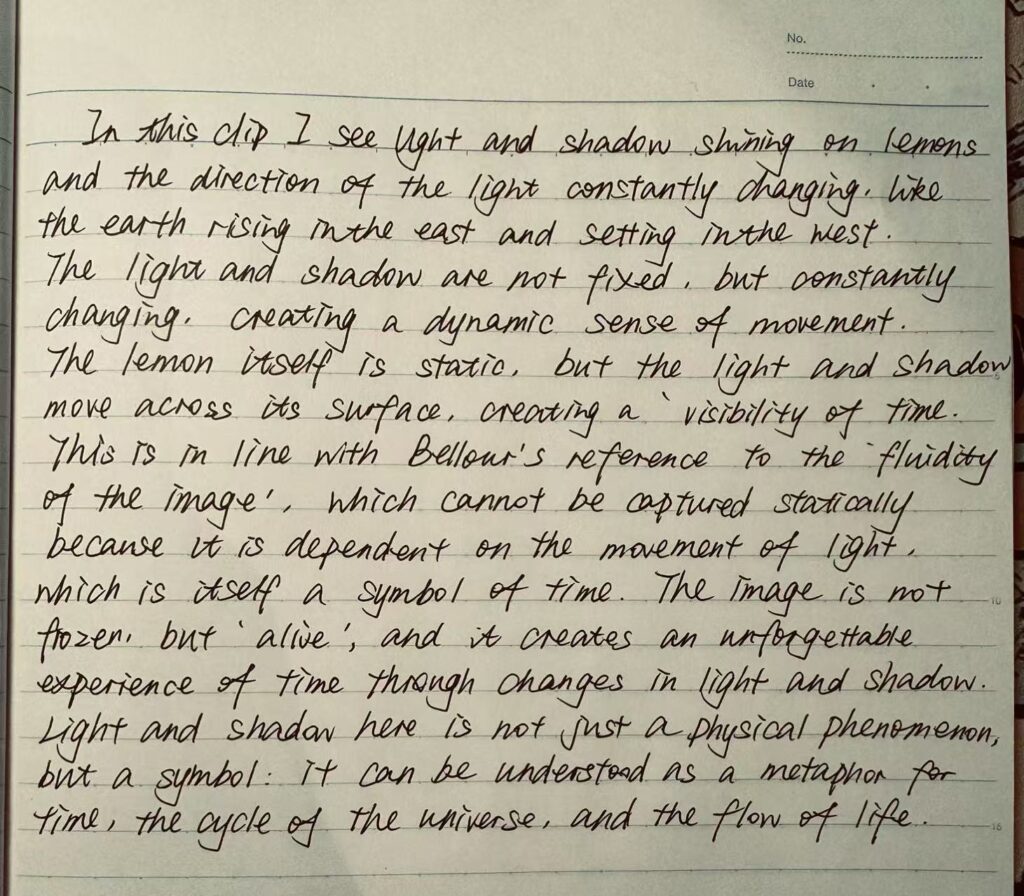
Time is based on how the medium shapes the viewer’s perception of metamorphosis and adaptation. If an ordinary lemon can show such a dynamic state under light and shadow, can I use a similar approach to express the shaping, fragility and adaptability of life in my exhibition? This discussion gave me a new direction, and I began to think about how to use light, shadow, video, sound and other elements to give the exhibition a ‘temporality’, so that it is no longer just a static viewing experience, but a perception process with a sense of flow.
Case Study I: A Little Death (2002) and Still Life (2001) by Sam Taylor-Johnson
It also reminds me of Sam Taylor-Johnson’s A little death(2002) and Still Life(2001), a time-lapse video showing a still life of fruit from freshness to decay.
.jpg)
-.jpg)
Traditionally, galleries tend to adopt a linear mode of viewing, but time-based works often require a freer, more immersive experience. This is particularly important for my exhibitions, as I want the viewer to feel ‘in’ a space that is changing and shaping, rather than being a passive viewer. I started to think about new possibilities, for example:
- Non-linear curatorial layout: visitors can freely enter different areas of the exhibition instead of following a fixed viewing path.
- Interactive images: combining projection, dynamic light and shadow, and sensor-activated devices, allowing the exhibition space to change subtly with the movement of the audience.
- Variable materials: Introducing materials that change over time (e.g. melting wax, slow-corroding metals, organic materials that absorb water), allowing the works to change visibly over the course of the exhibition.
Case Study II: Dreaming (2011) by AF Vandevorst
One artwork that deepened my thinking about the relationship between time, embodiment, and vulnerability was Dreaming by AF Vandevorst, presented at the 2011 Arnhem Mode Biennale. This installation features a full-scale wax sculpture of a young girl lying in a hospital bed. Both the figure and the hospital setting—bed frame, mattress, and pillow—are made entirely of wax, creating a strikingly sterile yet intimate atmosphere that evokes both clinical detachment and emotional fragility.
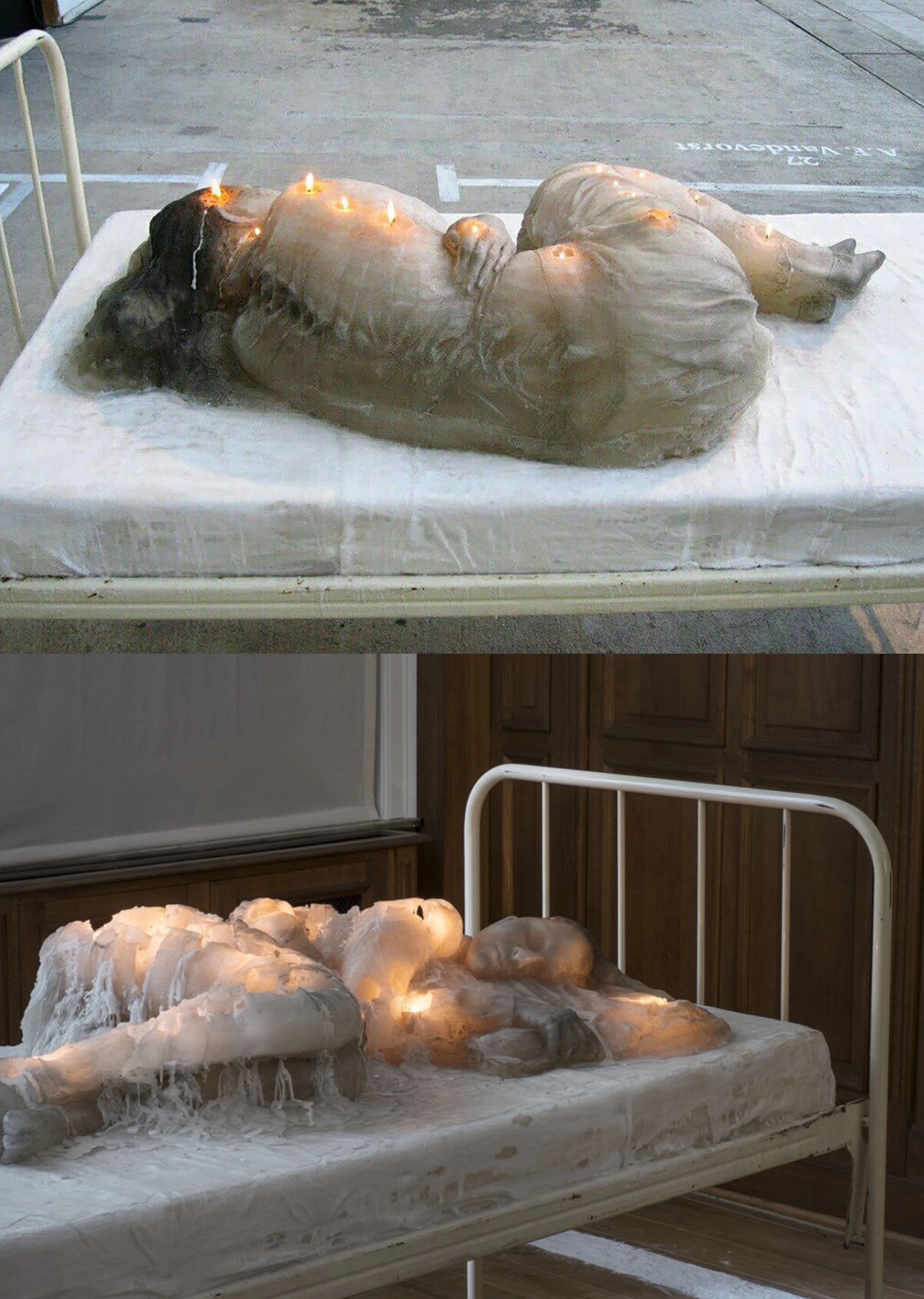
What makes Dreaming especially powerful is its gradual transformation. Over time, the wax slowly melts, deforming the perfect contours of the sleeping body. This temporal process is not just a visual spectacle but a visceral metaphor for mortality, echoing the impermanence of life and the silent erosion of the body.
The choice of a hospital scene is significant. Hospitals are spaces of both care and vulnerability, where the line between healing and loss is constantly negotiated. By freezing such a moment in wax, then allowing it to dissolve, the artists emphasize how fragile and ephemeral human life truly is.
Moreover, the work is inherently participatory. While not interactive in the traditional sense, the viewer’s presence is essential—the sculpture changes before their eyes, asking them to witness not just the artwork, but the metaphorical unfolding of life slipping away. This temporal intimacy creates a shared space of reflection, positioning the audience not just as spectators, but as quiet companions to a fleeting moment.
This piece resonates with my own curatorial interests in materiality, time, and the body. It encourages me to think more critically about how installation art can embody temporality—not just thematically, but physically—and how decay or transformation might be embedded into exhibition design.
I have also mentioned these inspirations during my visit to the corpse flower exhibition at cap professional. Curating is not only about exhibiting works, but also about how to make the audience feel ‘time’. Time can not only be a ‘background’ of the exhibition, but also the main narrative of the exhibition, so that my exhibition can be truly ‘shaped’ rather than just a static display.
Reframing Time: Towards My Own Curatorial Project
Reflecting on these moving image pieces has led me to identify “time-based transformation” as a key curatorial concern in my exhibition The Plasticity of Life. This project explores how bodies, identities, and materials are constantly reshaped by emotional memory, ecological rhythms, and embodied experiences.
In connection to this, my earlier artist research offered key insights:
•Olivia Azzopardi’s SKINS presents skin as both archive and interface—her work’s slow texturing and material trace feel deeply time-bound.
•Ella Binstead’s forms seem suspended mid-transformation, as if time were paused inside material.
These artists made me realise that time is not just a theme—it’s a method, a structure, and even a medium. In my current layout plans, I’m considering how lighting, pacing, and spatial transitions can reflect stages of transformation: fragmentation, absorption, reconfiguration. For example, I imagine dim, shifting lighting in one gallery zone, and gradual sound layering in another—mirroring how memory and identity re-form through repetition and decay.
This integration of artistic research, lecture theory, and spatial design has helped me approach time not as a constraint, but as a curatorial collaborator—a way to hold bodies, moments, and meanings in flux.
References
1.Taylor-Johnson, S. (n.d.) Sam Taylor-Johnson. Available at: https://www.samtaylorjohnson.com/ (Accessed: 21 March 2025).
2.Balsom, E., Connolly, M. and Iles, C. (2013) ‘Thoughts About Curating Moving Images’, Mousse, 38 (April), pp. 56–61.
3.King, J. and Simon, J. (2014) ‘Before and After UbuWeb: A Conversation about Artists’ Film and Video Distribution’, Rhizome. Available at: https://rhizome.org/editorial/2014/feb/20/and-after-ubuweb-distributing-artists-film-and-vid/ (Accessed: 21 March 2025).
4.Taylor-Johnson, S. (2001) Still Life [Video installation]. London: White Cube. Available at: https://www.youtube.com/watch?v=H1fF7cP0L_8 (Accessed: 21 March 2025).
5.Taylor-Johnson, S. (2002) A Little Death [Video installation]. London: White Cube. Available at: https://www.samtaylorjohnson.com/works/a-little-death (Accessed: 21 March 2025).
6. AF Vandevorst. (2011). Dreaming [Installation]. Arnhem Mode Biennale.
7. Phelan, P. (1997). Mourning Sex: Performing Public Memories. London: Routledge.
8. Jones, A. (2012). Seeing Differently: A History and Theory of Identification and the Visual Arts. New York: Routledge.
cover © 2025 by Chuni Mao is licensed under CC BY-SA 4.0
Class Photos 1 © 2025 by Chuni Mao is licensed under CC BY-SA 4.0
Class Photos 2 © 2025 by Chuni Mao is licensed under CC BY-SA 4.0
In-class writing notes © 2025 by Chuni Mao is licensed under CC BY-SA 4.0
Still Life 2001(1) © 2025 by Chuni Mao is licensed under CC BY-SA 4.0
Still Life 2001(2) © 2025 by Chuni Mao is licensed under CC BY-SA 4.0
Dreaming, 2011, wax sculpture © 2025 by Chuni Mao is licensed under CC BY-SA 4.0
